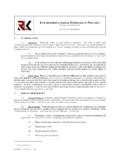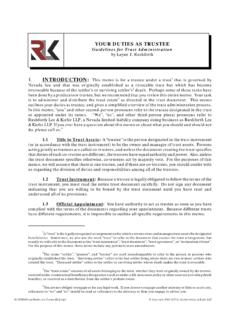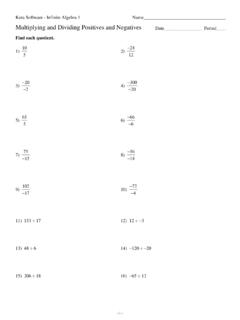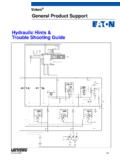Transcription of DIVIDING A TRUST INTO SUBTRUSTS AFTER A …
1 DIVIDING A TRUST into SUBTRUSTSAFTER A SETTLOR S DEATHF unding Separate SUBTRUSTS Created under a Trustby Layne T. RushforthSection 1. Overview: This memo is directed to the trustee of a revocable TRUST where the trustrequires the allocation of TRUST assets into two or more SUBTRUSTS at the time of the settlor s death, or, in thecase of a two-settlor TRUST , at the time of the settlor who dies first ("deceased settlor" or decedent ). Traditionally, this type of planning has been done by married couples, but it also works for domesticpartners and unrelated individuals; however, planning involving a TRUST that qualifies for the maritaldeduction for federal estate tax purposes does not apply if the surviving settlor is not married (as definedunder federal law) to the deceased of Division.
2 The division of a TRUST is frequently tax motivated, but it can also berequired because of a desire to preserve assets for specific beneficiaries (such as the children of the deceasedsettlor), and/or a desire to protect assets against the claims of creditors and the impact of divorce and Estate Tax. The federal estate tax rate is 40%.1 The amount of property that canbe transferred free of the estate tax is referred to as the applicable exclusion amount , which is $5,490,000in of Caution. This memo speaks in general terms and refers to TRUST provisions that aretypical. This memo was not written with any specific TRUST in mind. Each TRUST is unique, and you shouldread the TRUST documents carefully and confer with a CPA or with us or another attorney who is experiencedin TRUST administration and estate tax matters.
3 This memo does not discuss your duties to administer thesubtrusts AFTER they are created and funded. For that, you should read the memo titled Your Duties asTrustee .3 Section 2. Two-Settlor Trusts: Most of the two-settlor trusts that require a division when onesettlor dies are designed either as an A/B TRUST or as an A/B/C TRUST . TRUST . Upon the decedent's death, the typical "A/B TRUST " is divided into two SUBTRUSTS ,which are labeled as the Survivor s TRUST and the "Decedent s TRUST " in Figure 1. It is called an A/B Trustbecause the Survivor s TRUST is referred to as TRUST A, and the Decedent s TRUST is referred to as TRUST (a)Survivor's TRUST .
4 The "Survivor's TRUST " or TRUST A receives all of the survivingsettlor s assets plus the decedent's assets to the extent the value exceeds the applicable exclusionamount . In most cases, the surviving settlor will have the right to amend and revoke the"Survivor's TRUST ". This TRUST is usually designed to qualify for the estate tax marital deduction ifthe settlors are married at the time of the first death of a maximum rate imposed for federal estate tax purposes is currently 40%. For the rates in prior years, # Revenue Code 2010(c) provides for an applicable exclusion , which is the cumulative amount that can passfree of gift and/or estate tax.
5 The applicable exclusion is $5,430,000 for 2015, $5,450,000 in 2016, and $5,490,000 in 2017. For the applicable exclusion in prior years, see # is available online at way to remember which TRUST is which is to keep in mind that TRUST A is for the settlor that is Alive, and TRUST Bis for the settlor that is Buried. Most trusts do not use the TRUST A and TRUST B designations, but it is still common to refer tothese trusts as A/B Trusts .M:\FORMS\cm\ DIVIDING A-B-C A TRUST into SUBTRUSTS Copyright 1988-2017 by Layne T. RushforthPage 2 of 6 PagesFigure 1(b)Decedent s TRUST . TheDecedent s Trust5 or TRUST B receives asmuch of the deceased settlor s propertythat can pass free of the estate This is done primarily so that thedecedent s applicable exclusionamount is preserved without furtherestate taxation and without beingsubject to the claims of a beneficiary screditors or to dissipation in abeneficiary s divorce proceeding.
6 Thesurviving settlor may be (and usuallyis) the beneficiary of the Decedent sTrust, and the TRUST may permit thesurviving settlor to direct distributionsfrom the TRUST either during thesurviving settlor s lifetime or AFTER thesurviving settlor s death or TRUST . An A/B/C TRUST is only for couples who are married (as defined in federal taxlaw).7 Upon the decedent's death, the typical "A/B/C TRUST " or A/B/QTIP divides into three SUBTRUSTS . (See Figure 2.)(a)Survivor's TRUST . In a typical "A/B/C TRUST ", the "Survivor's TRUST " or TRUST A isa TRUST for the surviving settlor s assets, and the surviving spouse has the right to designate who willbe its beneficiaries upon the survivor's death.
7 This TRUST receives all of the surviving settlor s assetsbut none of the decedent's assets.(b)Decedent s TRUST . In an "A/B/C TRUST ", the "Decedent s TRUST " or TRUST B is anirrevocable TRUST that receives assets that are covered by the applicable exclusion . This is usuallydrafted as a spendthrift TRUST that is exempt from the claims of the surviving spouse s creditors.(c)Marital TRUST . T h e M a r i t a l T r u s t o r T r u s t C is an irrevocable TRUST that qualifiesfor the marital deduction. This TRUST can either be a "Qualified Terminable Interest Property TRUST "(often called a "QTIP TRUST ")8 or it can be a life estate/general power of appointment TRUST ,sometimes referred to as a B5 TRUST .
8 9 Under either type of marital TRUST , the surviving spouse isentitled to all of the TRUST 's income each year and may permit the invasion of the TRUST 's principal forthe surviving spouse's benefit. The QTIP TRUST rules do not permit anyone other than the survivingspouse to receive distributions from the TRUST during the surviving spouse's lifetime, but it maypermit the surviving spouse to direct distributions from the TRUST AFTER the surviving spouse's death. 5 Although this memo refers to the Decedent s TRUST , it may be named something else in your TRUST documents. Common names include Credit-Shelter TRUST , Bypass TRUST , Exemption TRUST , and Exclusion TRUST .
9 6 This is the applicable exclusion amount that has not been used for lifetime gifts. The applicable exclusion amount is given in note 2 at the bottom of page Nevada s domestic partnership laws give domestic partners exactly the same rights as married couples, currentfederal tax law does not recognize domestic partners as being married. Federal law does recognize same-sex a QTIP TRUST is used, the TRUST may be referred to as an "A/B/QTIP TRUST " or an "A/B/Q TRUST ".9 This type of TRUST gets its name because it is described in IRC 2056(b)(5).M:\FORMS\cm\ DIVIDING A-B-C A TRUST into SUBTRUSTS Copyright 1988-2017 by Layne T. RushforthPage 3 of 6 PagesFigure 2 The life estate/general power of appointment Marital TRUST requires that the surviving spouse havethe power to direct distributions from the TRUST at his or her 3.
10 Division of One-Settlor TRUST : In the case of a one-settlortrust, the TRUST is commonly divided betweena Decedent s TRUST and a second TRUST , suchas a Marital TRUST or a Survivor s TRUST , in amanner similar to the division of a two-settlor TRUST as described in section 2, above. While a Survivor s TRUST is usually revocable,that is frequently not true in a 4. TRUST AllocationFormulas: Under both an A/B TRUST and anA/B/C TRUST , upon the death of the decedent,the TRUST must be divided into the trusts asdirected in the TRUST document. Sometimes,specific assets are allocated to the differenttrusts, but usually the TRUST is dividedaccording to a stated formula.










